We’ve been sharing stories from Comny’s Tokyo adventures, and today we’d like to offer a spin-off focusing on Comny’s learning journey.
You can check out the main story of the Tokyo adventures here:
af-liquor and Déguergement Episode
Wine Station+ Episode
Day 2
A prestigious restaurant named Abysse, which has maintained a Michelin star since 2016, played a significant role in this Tokyo adventure.
Chef Koutarou Meguro, who trained in France and refined his skills at the three-star restaurant “Quintessence,” is the mastermind behind this establishment.
Abysse offers a seafood-centric French cuisine menu, ranging from amuse-bouche to the main courses.
What kind of dishes were served? Let’s dive in and find out.
Check it out!
Cheers!
After entering the restaurant, we were guided to our seats. The first step was to confirm with the sommelier whether it was okay to take pictures.
The response was a casual “Sure thing!” (translated), so I snapped a photo of the kitchen.
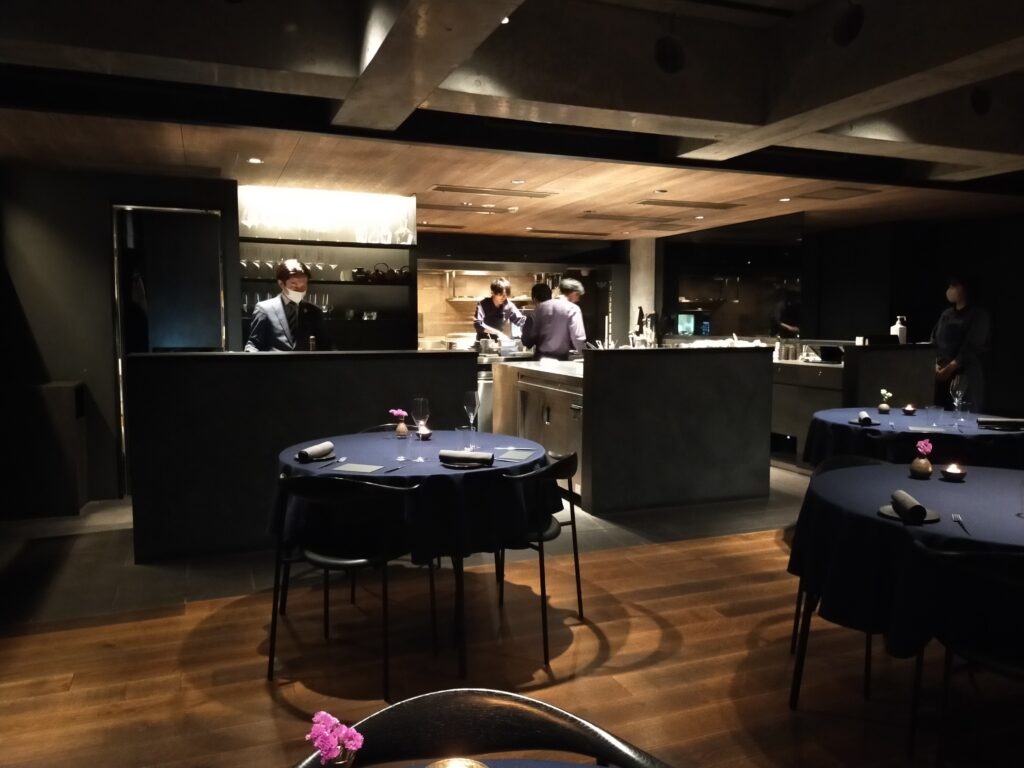
The lively energy of the kitchen was captivating—watching the activity alone is enough to finish off a bottle of champagne effortlessly.
The lighting and tablecloths created a calm and stylish atmosphere. The dedicated space for the sommelier also added a touch of elegance.
Upon sitting down, this was the table setup:
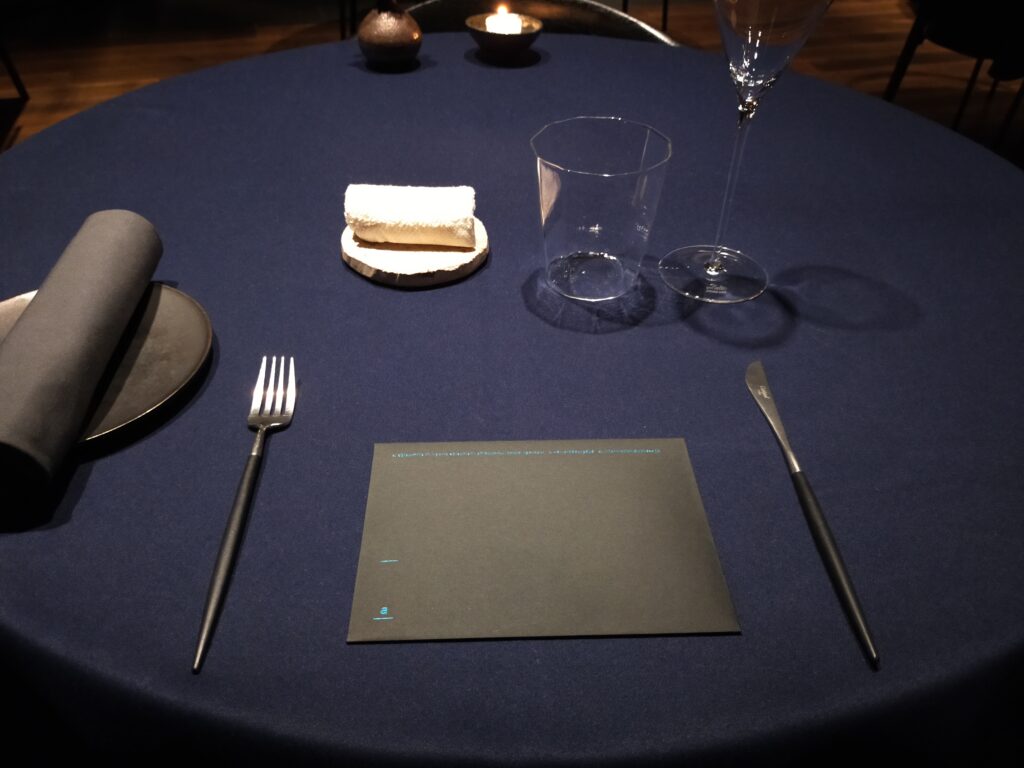
There was something resembling a letter on the table.
“Oh, a sudden confession? How bold!”
Such whimsical thoughts crossed my mind, but upon opening it, I discovered it was the drink menu.
Comny had arrived with the firm intention of ordering pairings, so as soon as I realized it wasn’t a love letter, I swiftly closed and returned it to its original spot.
Nonetheless, it was a charming presentation.
Having prepared myself with Hepalyse and other supplements, I decided to go with a smaller portion of wine pairing, mindful of what lay ahead.
Thus, the first glass served was:
Brice Heritage Brut N.V
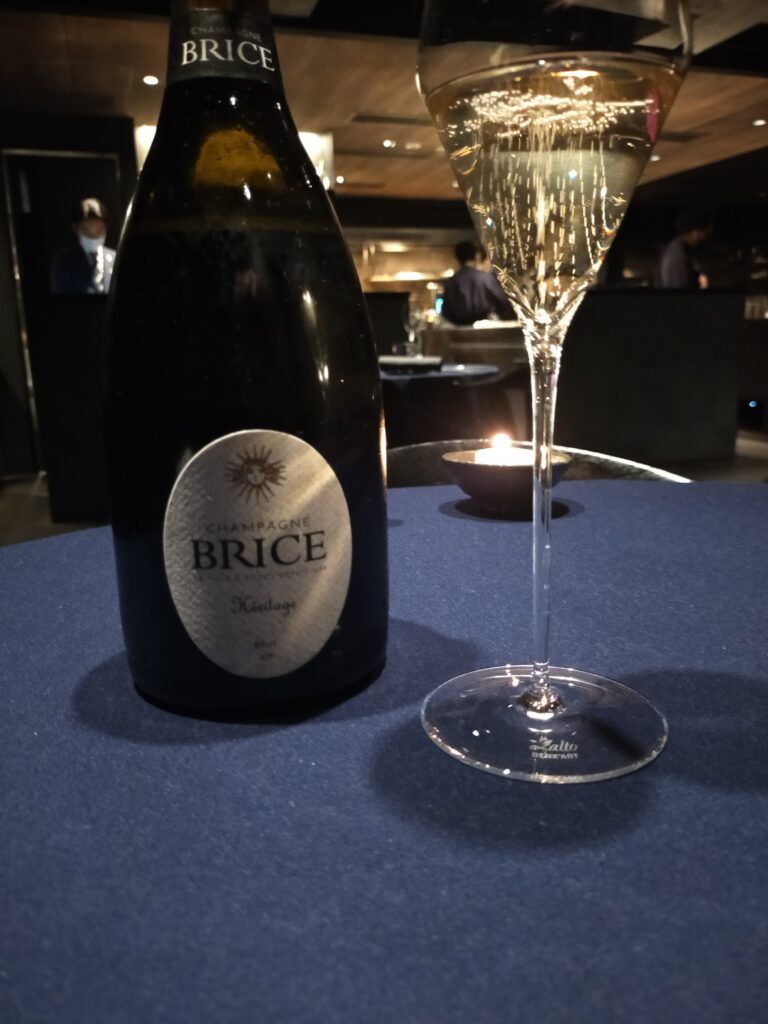
“This champagne isn’t particularly well-known, but it’s truly marvelous,”
the sommelier explained while pouring.
Although not a Champagne connoisseur, I had tasted this one before—just the day prior, in fact.
During the three-champagne comparison at Déguergement, this was one of the selections provided. Even with my forgetful nature, I remembered it vividly.
The gentle aroma of citrus like lemon and orange, coupled with the rich yeastiness akin to brioche, added depth to the flavor.
Its refreshing and lively apple acidity made it a perfect start to the pairing—truly delightful.
The First Dish
Here’s the long-awaited amuse-bouche.
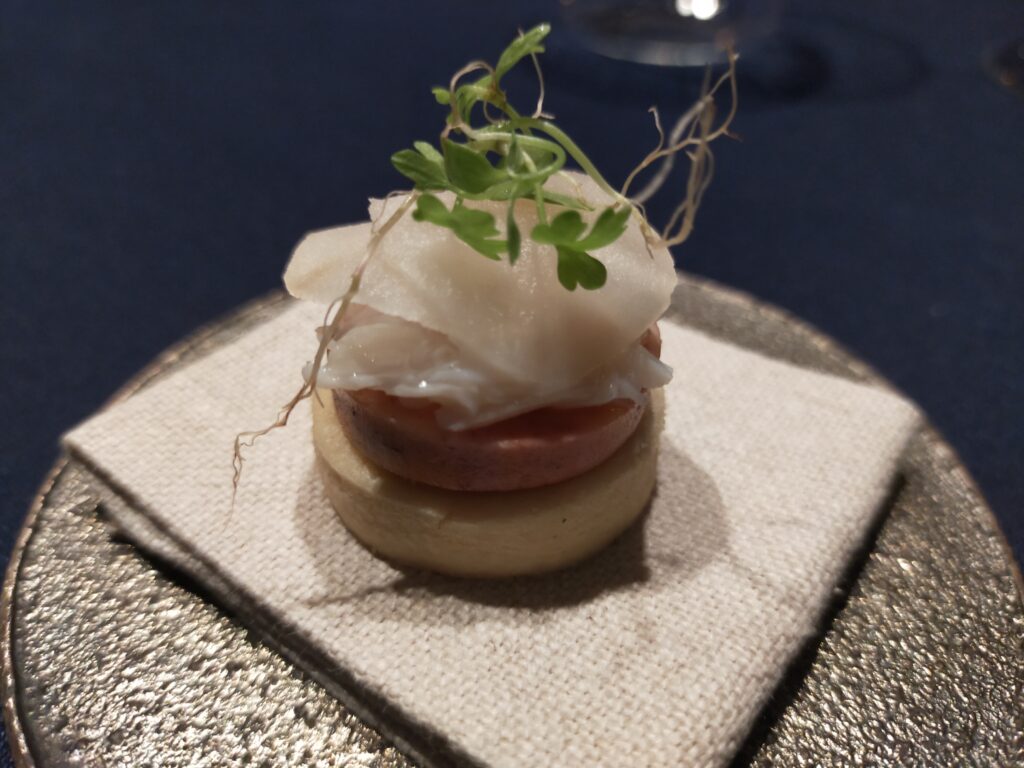
Its size is perfectly suited for a refined bite. The primary ingredients are monkfish liver and horsehair crab.
The base layer is a warm, delicate, and crumbly sablé with a hint of saltiness.
The horsehair crab is enhanced with bonito broth for added umami and is dressed with a tangy jelly, resulting in a dish that’s flavorful yet refreshing.
The balance with the monkfish liver is impeccable.
The temperature and saltiness of the sablé are truly masterful.
Several slices of Jerusalem artichoke are placed on top, adding a wonderful textural contrast—it’s incredibly delicious.
It’s amazing how so many elements are packed into a single bite-size dish.
This stuff’s so good, I legit can’t stop chugging champagne. It’s kinda ridiculous, but hey, no complaints!
Second Dish
The dish arrived with the warning, “Be careful, it’s hot!”
Oyster Flan
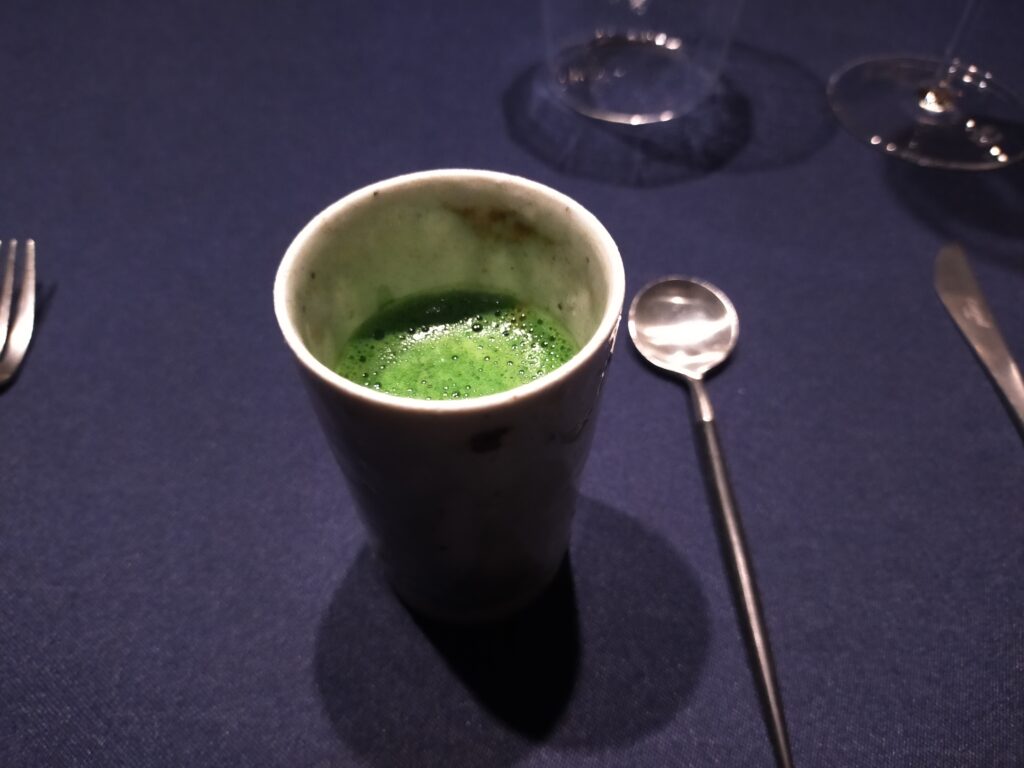
The base was a freshly made, delicate and wobbly flan (similar to Japanese egg tofu), topped with fresh oysters cut into concasse (about 1 cm cubes).
The oysters had been dressed with lemon juice, which added just the right amount of tanginess to enhance their umami flavor. A few drops of tea-infused oil were drizzled over, bringing a pleasant bitterness and aroma that tied the dish together beautifully.
The vibrant green liquid was a clam broth mixed with spinach soup—warm and utterly comforting.
The mineral quality of the oysters, the lemon’s acidity, and the tea’s bitterness resonated harmoniously with the champagne’s flavor profile, creating an absolutely delightful pairing.
The balance of flavors was truly impressive—this is what restaurant pairings are all about, and it brought me so much joy.
I’m so glad I came here (and we’re only on dish two, haha).
Third Dish
To accompany the next dish, we had the following wine:
Skerlj Vitovska 2019
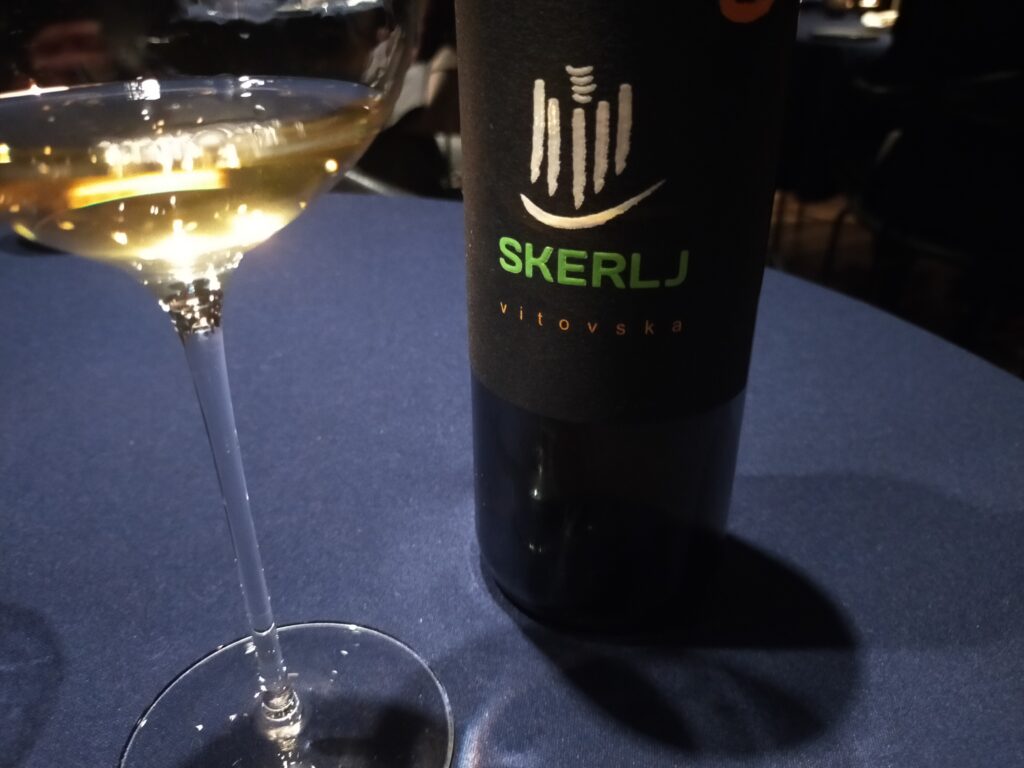
This wine hails from northern Italy’s Friuli-Venezia Giulia region and is made using the Vitovska grape variety.
“It’s a wine from Friuli, often called the holy land of white wine. Due to extended maceration, it falls into the orange wine category,” the explanation went.
Although an orange wine, it wasn’t overly eccentric, retaining a muscat-like aroma. The wine was clean with lovely acidity and a subtle saline quality.
And now for the dish:
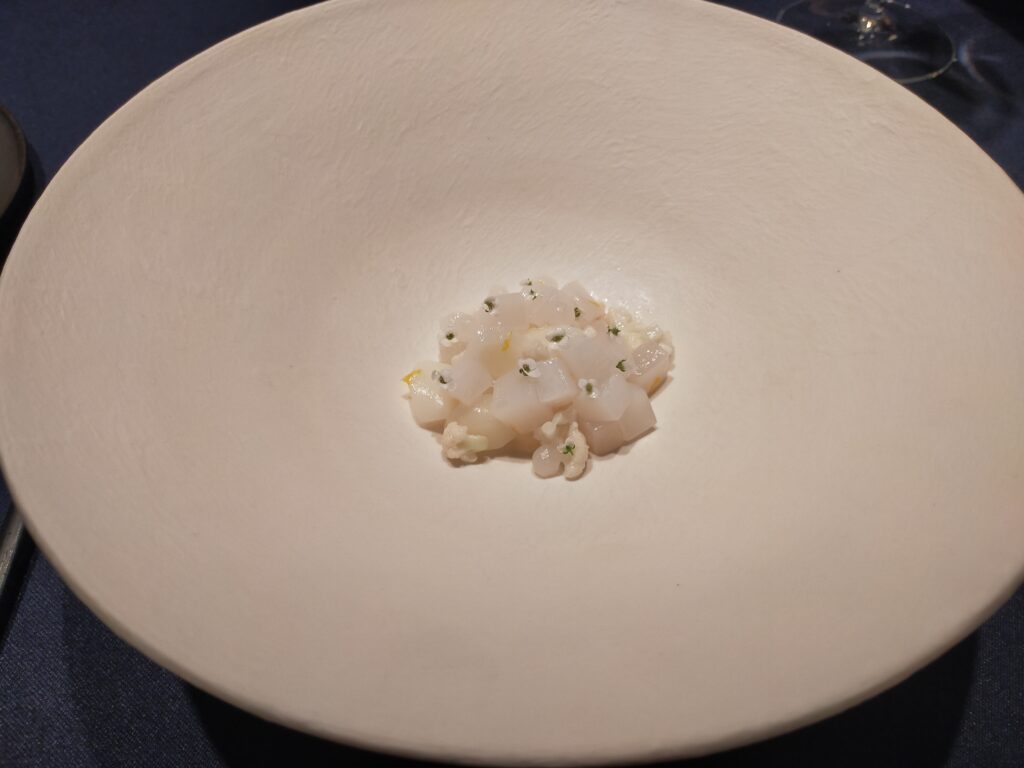
“We’ve prepared cuttlefish for you,” the server announced as the plate arrived.
The dish had an elegant and refined appearance, featuring an all-white color scheme. Stunning presentation.
To finish the dish, the server poured the accompanying soup at the table.
The cuttlefish had a delightfully springy and sweet texture when raw, but with a quick sear on the surface, it developed a crispy texture, enhancing its natural sweetness.
The dish was paired with seasonal winter vegetables: cauliflower, turnips, and lily bulbs, along with a small touch of yuzu zest, which provided a delightful accent.
The soup was a kombu-based broth extracted from grilled cuttlefish tentacles. While the salt content was subtle, the gentle umami from the kombu, along with the sweetness and aroma of the tentacles, left nothing lacking.
The crisp texture of the cuttlefish, the sweet lily bulb, and the contrasting textures of the turnip and cauliflower were simply delightful.
The aromatic and slightly saline wine complemented the dish beautifully.
It was truly a wonderful and delicious experience.
Fourth Dish
To pair with the next dish, we were served the following wine:
Vincent Pinard Sancerre Nuance
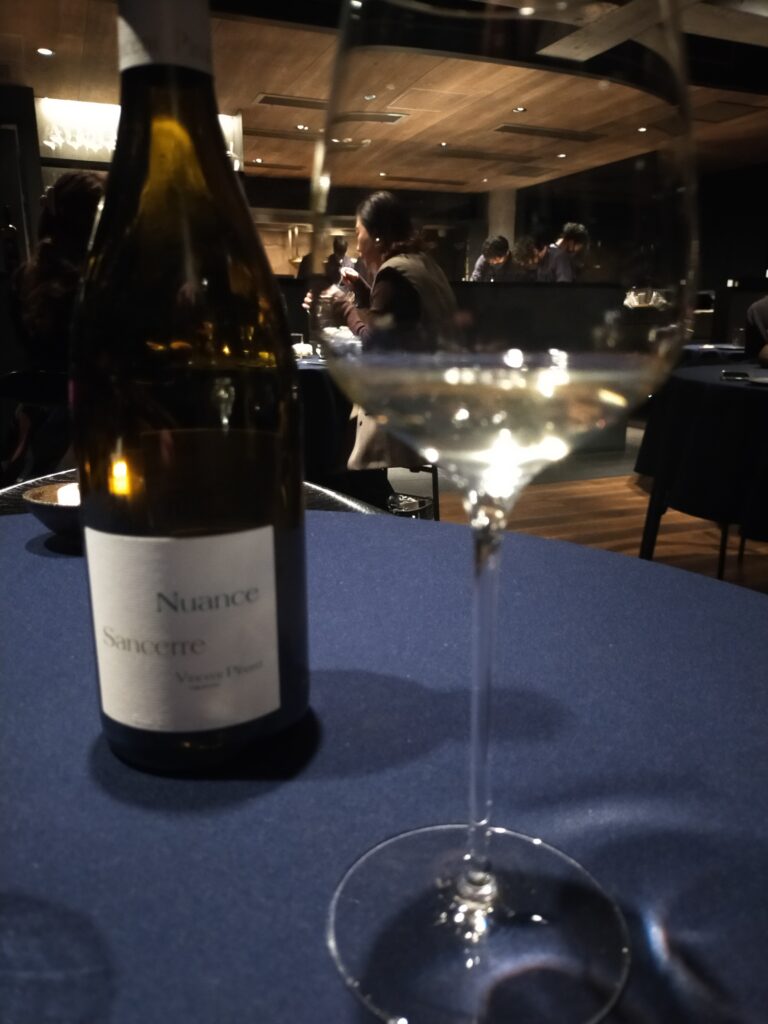
This wine is made from Sauvignon Blanc grapes in the Loire Valley, France.
Sauvignon Blanc, when grown in warmer regions, often has tropical fruit aromas that are quite bold and popular. However, Sauvignon Blanc produced in Sancerre, with its cooler climate, tends to be crisp and sharp, with citrus and herbal notes, and often a touch of green freshness.
Tasting it, the wine felt refreshing, with a complexity brought out by smoky barrel notes.
The dish was White Marlin.
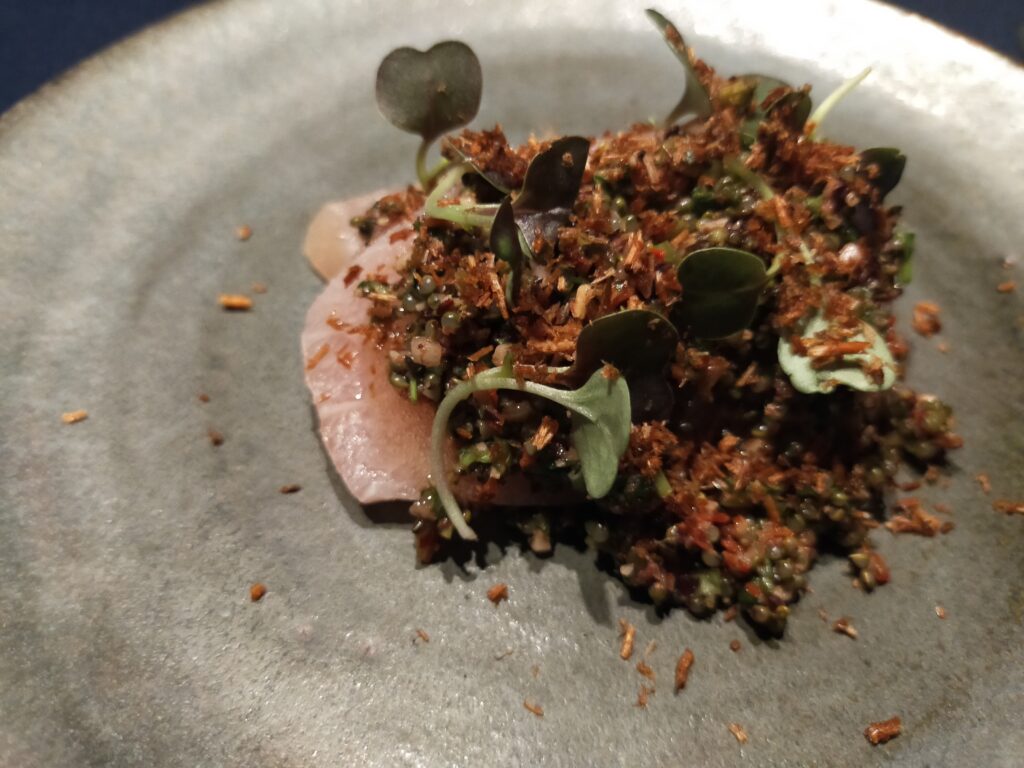
It’s a large and very rare fish species. Though the flesh had a pale color, its size likely contributed to its impressively rich fattiness.
The marlin was lightly cold-smoked with straw, giving it a lovely smoked aroma without any actual cooking (think smoked salmon vibes).
On top, there were garnishes that acted as a kind of sauce: sprouted radish, Japanese parsley (seri), fried seri roots, black olives, dried tomatoes, and tonburi (a plant seed often called “land caviar”).
The smokiness of the fatty marlin was beautifully balanced by the acidity of the dried tomatoes.
When paired with the wine, the green freshness of the Japanese parsley, the subtle smokiness, and the tangy acidity of the dried tomatoes intertwined perfectly. What lingered on the palate was the fruity elegance of the Sancerre.
It’s simple yet multidimensional in flavor—absolutely remarkable.
Bread
Around this point in the meal, bread was served.
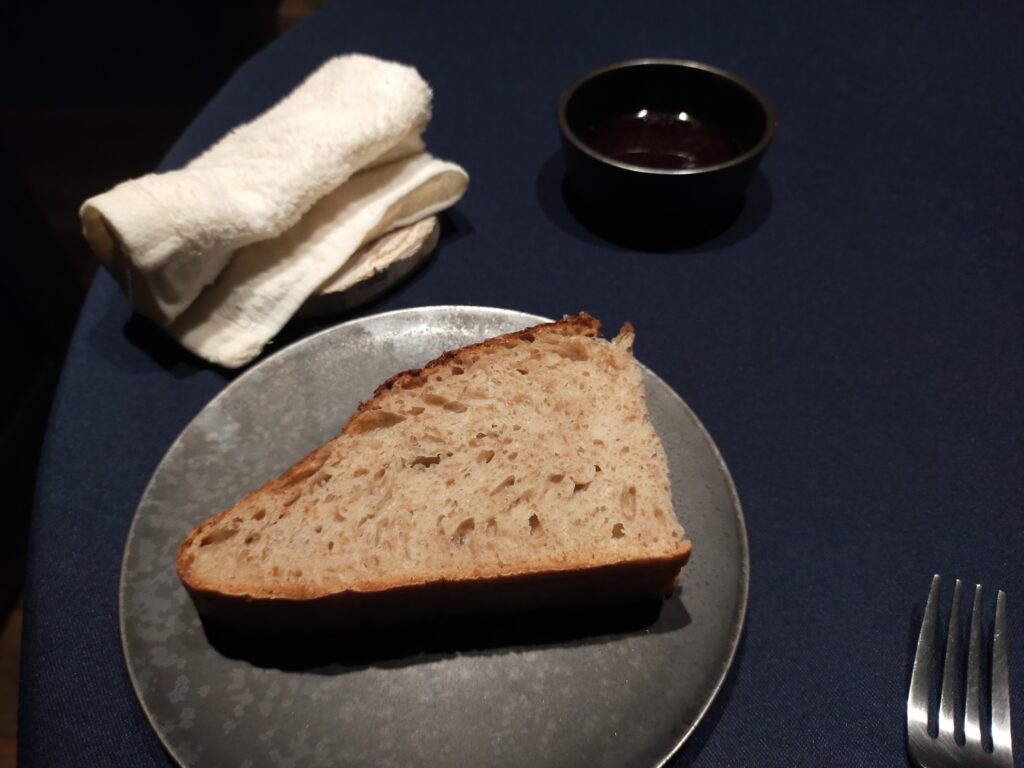
Instead of butter, it came with a sauce—a unique and interesting touch.
The sauce was made from black garlic and hemp seed oil. The signature mild yogurt-like acidity of black garlic added a delightful flavor.
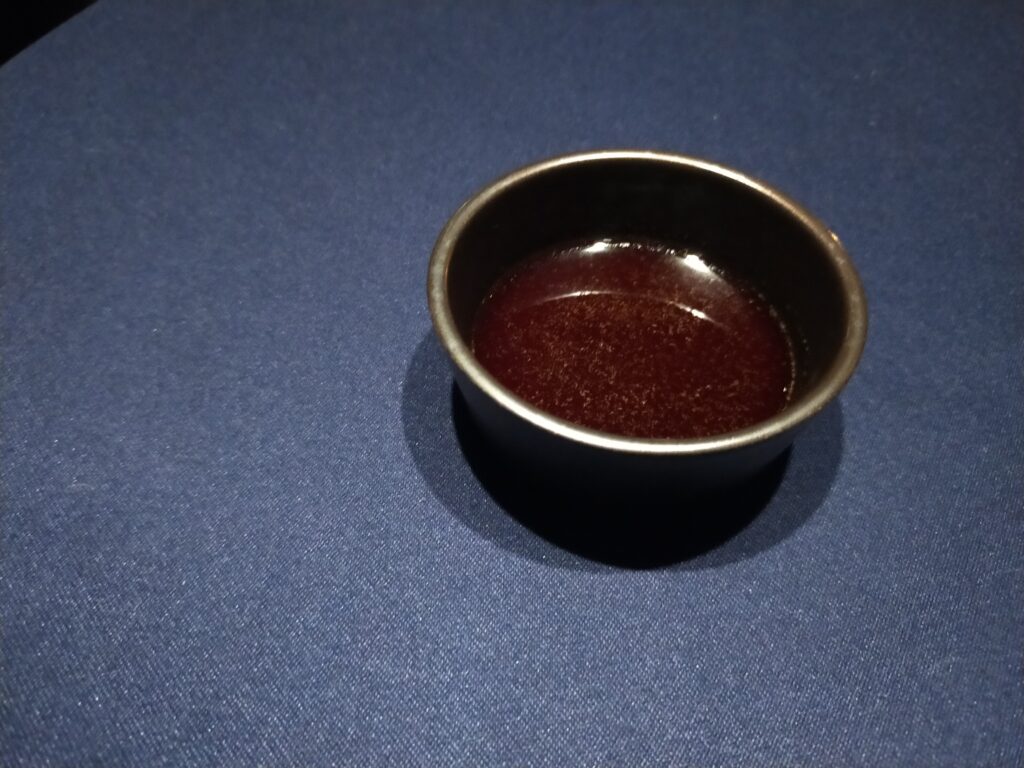
Comny personally felt the bread could’ve been warmed up a bit more, but it was wonderfully chewy, making it easy to scoop up the sauce and enjoy.
Fifth Dish
The next pairing wine was:
Domaine de Belliviere Coteaux du Loir L’effraie
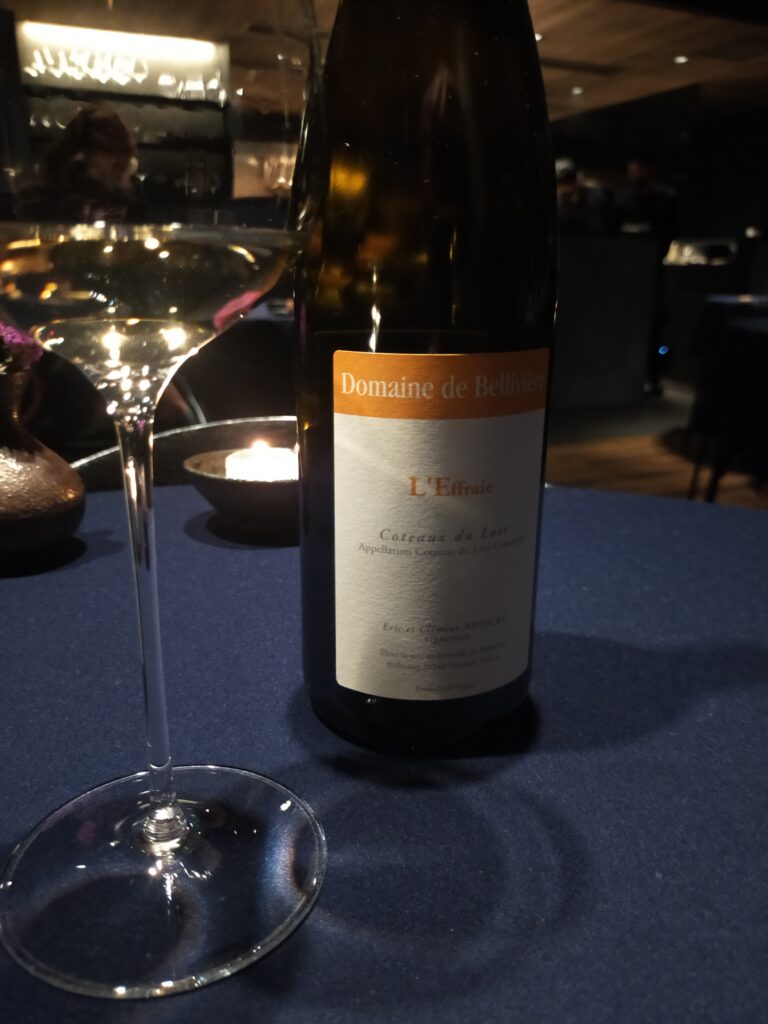
Another wine from the Loire region, made from Chenin Blanc grapes.
Coteaux du Loir is located in the northern part of the Loire region, specifically north of Chinon (I searched desperately on a map!).
The wine had fruity notes reminiscent of yellow peach and apricot, paired with clean acidity. While well-ripened, it maintained a refreshing, light feel without being heavy. Delicious!
While appreciating the wine, the dish arrived:
A dish featuring octopus.
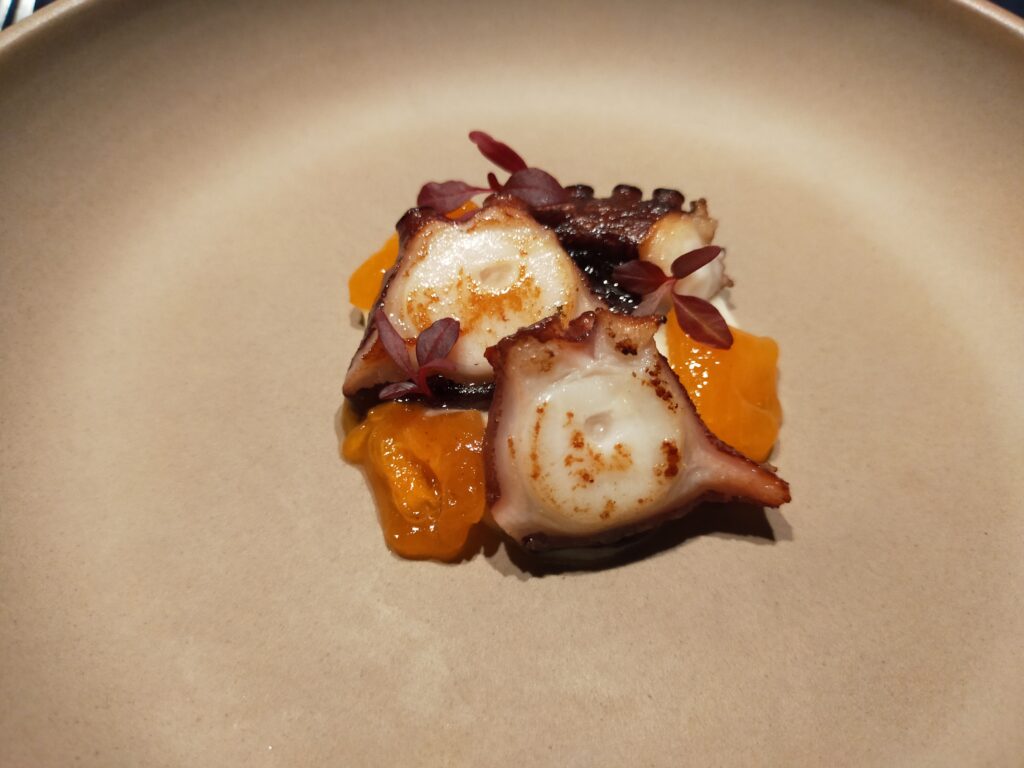
The octopus had been simmered until tender, then cut and grilled on the cut side for a toasty aroma.
Beneath it was a mashed potato purée infused with Mont d’Or cheese.
The orange-colored garnish was a homemade dried persimmon.
Absolutely incredible!
The octopus was so tender. Normally, overcooking octopus can make it tough, but this one was perfectly springy and aromatic.
The richness of the Mont d’Or cheese took the simple mashed potato purée to another level.
And that homemade dried persimmon—what a game-changer.
With or without it, the overall impression of the dish and the wine pairing would have been entirely different.
The sticky sweetness of the persimmon contrasted beautifully with the savory saltiness of the octopus and potato purée, bridging the flavors to the wine’s bright yellow fruit notes.
It was truly delicious. The aroma and aftertaste of the Chenin Blanc paired stunningly with the sweetness of the persimmon.
Sixth Dish
The next wine pairing was:
Domaine de Bonserine Cote-Rotie La Sarrasine 2015
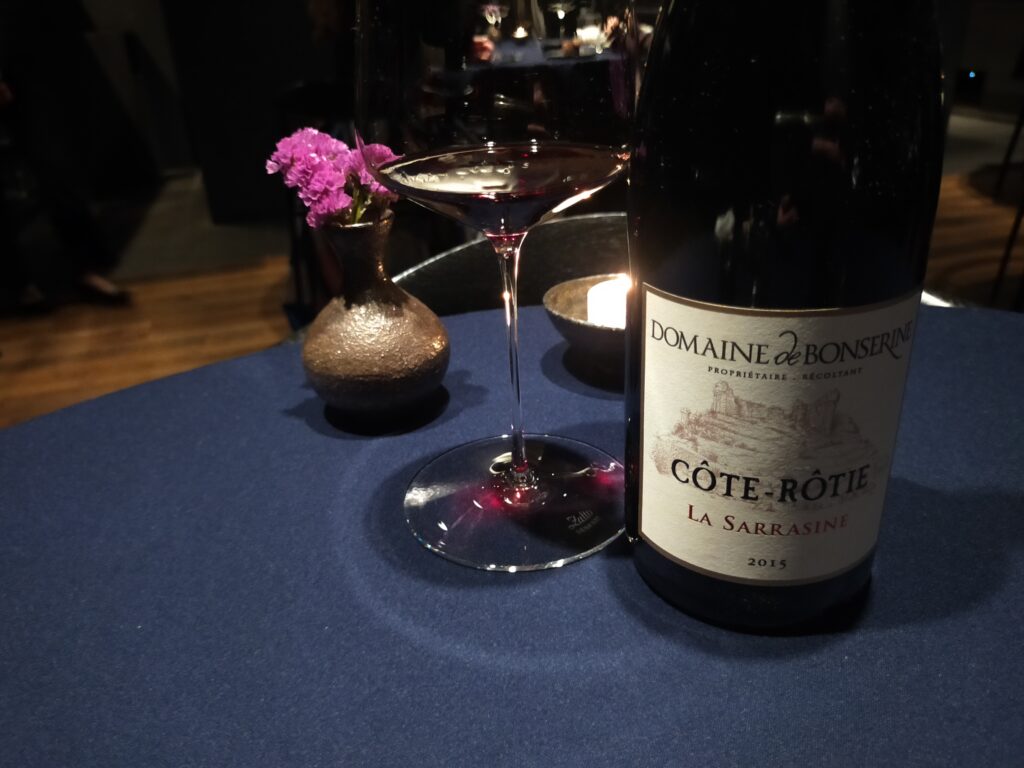
A surprising choice of red wine for the middle of an all-seafood course, and from Côte-Rôtie no less.
Côte-Rôtie is an appellation in the northern Rhône region of France.
Made primarily from Syrah, one might expect a bold, powerful wine, but due to the cold mistral winds blowing through the region, the wine is remarkably elegant—so much so that it’s sometimes mistaken for Burgundy’s Pinot Noir.
The sommelier explained, “I thought this wine might pair well with this course.”
Tasting it, the wine indeed had spicy nuances but was refined, with silky, well-integrated tannins.
It was absolutely delicious—just the kind of wine Comny loves.
And here is the dish paired with it:
Grilled Spanish Mackerel (Sawara)
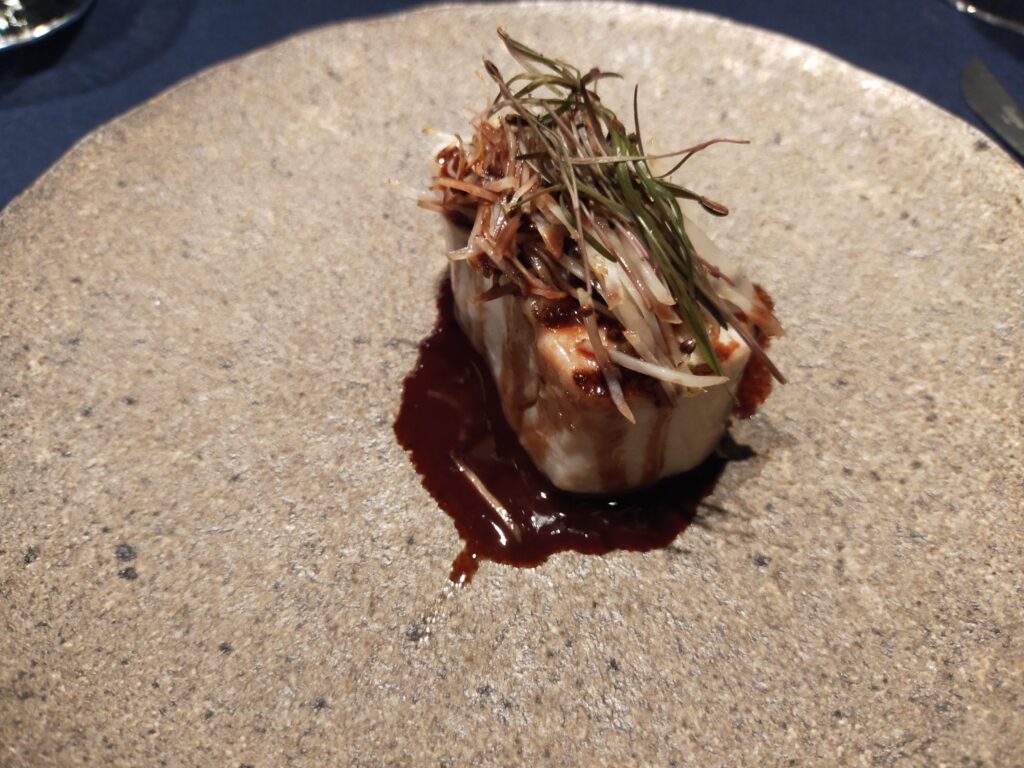
The fish was fluffy and tender, with a delicate smoky aroma from the high-heat grilling.
The thickness of the fish and the perfectly cooked texture—moist and succulent—were truly impressive.
The toppings included burdock root, perilla (egoma), and coriander seeds, while the sauce was a chicken stock-based red wine sauce.
The balance was flawless—not too heavy, not too light.
Spanish mackerel, when grilled, can sometimes have a metallic taste (a personal observation from Comny), but here, that metallic quality was cleverly paired with the red wine.
Of course, the sauce and garnishes closed the remaining gap, uniting everything seamlessly (not that I’m in a position to judge, haha).
It might sound simple, but the balance achieved here was extraordinary.
The earthy flavor of the burdock and the spiciness of the coriander seeds completed the dish.
It was so satisfying, you could almost forget you were eating fish.
This might be the true essence of Abysse’s cuisine—absolutely stunning.
I was blown away.
Seventh Dish
The next pairing wine was:
Ried Ulm Nussberg Wiener Gemischter Satz Wieninger
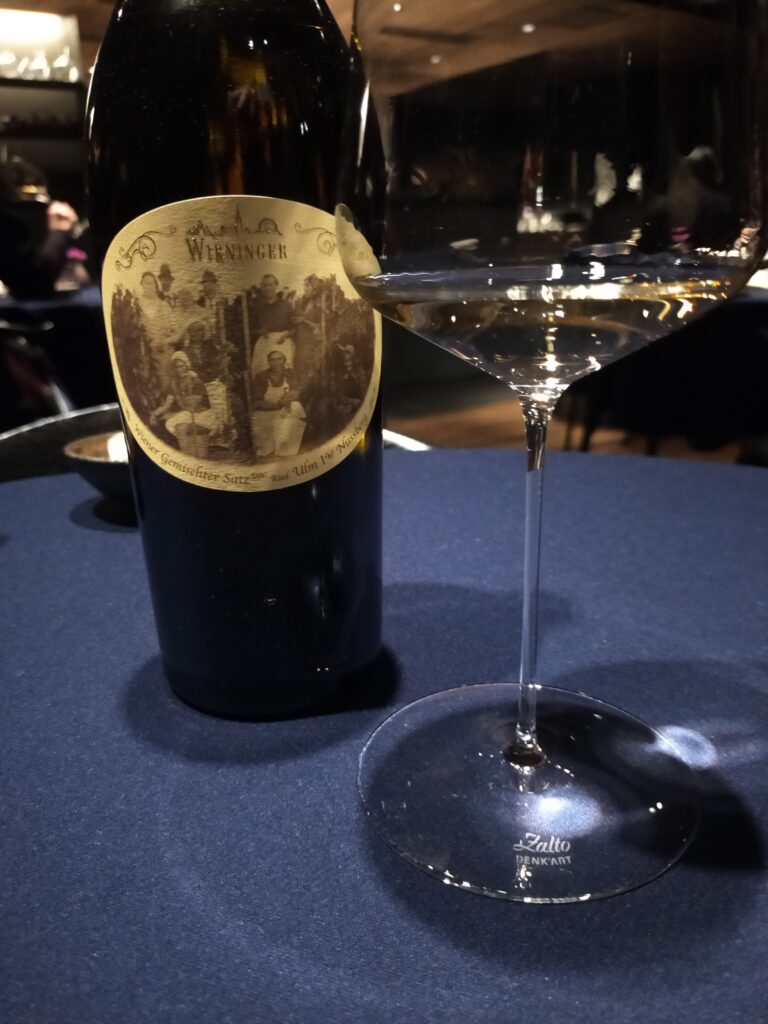
This wine is from Vienna, Austria, and belongs to the Wiener Gemischter Satz category. This type of wine is a blend of several grape varieties, such as Weissburgunder and Neuburger, which are mixed and fermented together.
Wiener Gemischter Satz became a certified DAC (appellation of origin) only recently, in 2013.
For Comny, it was his first time trying this wine.
The aroma had a floral or aromatic quality, but its tone was subdued, giving off a calm impression—somewhat hard to describe.
Its high citrus-like acidity, along with a slight hint of bitterness, stood out. Although it appeared mild at first glance, its alcohol content of 14.5% added an unexpected punch. A fascinating wine indeed.
And here’s the dish:
Pan-Seared Cod Milt (Shirako)
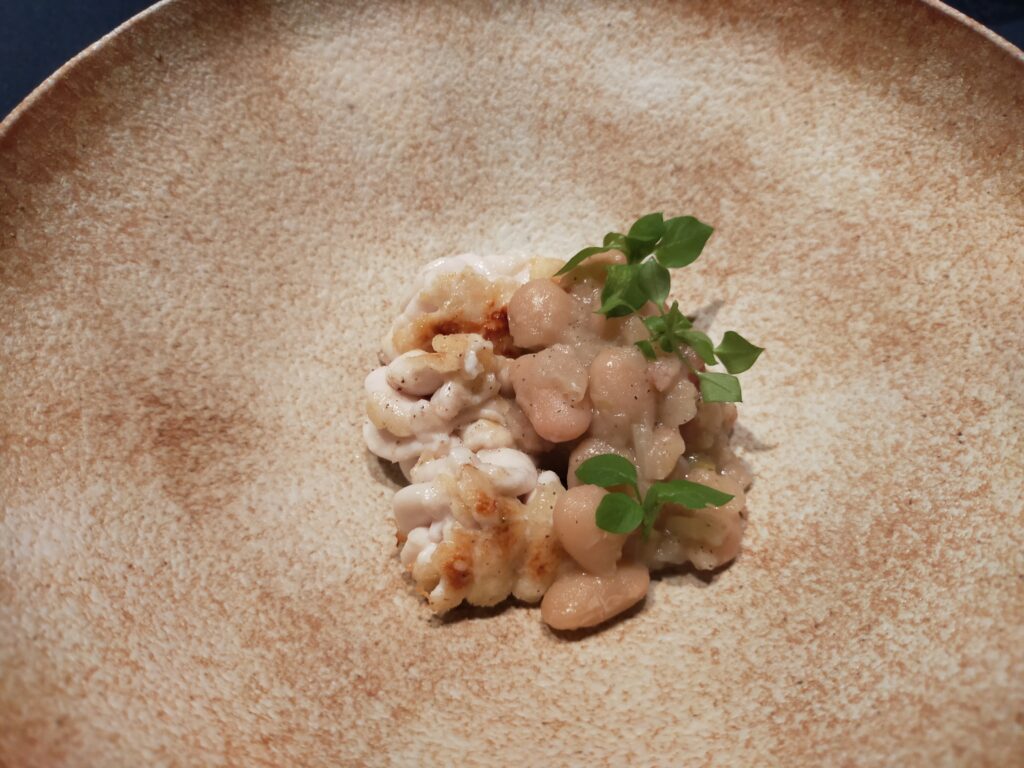
The accompaniments included leeks (poireau), celery root, and white beans, which had been slowly simmered until tender.
The piping hot and creamy shirako was simply delicious—its rich flavor refreshed beautifully by the wine’s citrus aroma. But the real surprise came when the wine was paired with the white beans.
The wine, which had seemed restrained earlier, suddenly took center stage. The 14.5% alcohol content was no joke.
It highlighted the sharp edges of the vegetables’ flavors while simultaneously asserting itself boldly.
Austrian wines, especially Grüner Veltliners, are well-known for their excellent compatibility with vegetables, and this Wiener Gemischter Satz was no exception.
The combination was astonishingly delicious. The transition from quiet to bold flavors made for a fascinating pairing experience.
Eighth Dish
The main course was paired with this wine:
Gevrey Chambertin 1er Cru Les Cazetiers
Unfortunately, I forgot to take a photo, so I don’t recall the producer.
The sommelier shared, “For the final pairing, I wanted to serve a wine like this.”
The dish was: Pan-Seared Golden Eye Snapper (Kinmedai)
The skin was perfectly crisped and charred, making it an excellent match for red wine.
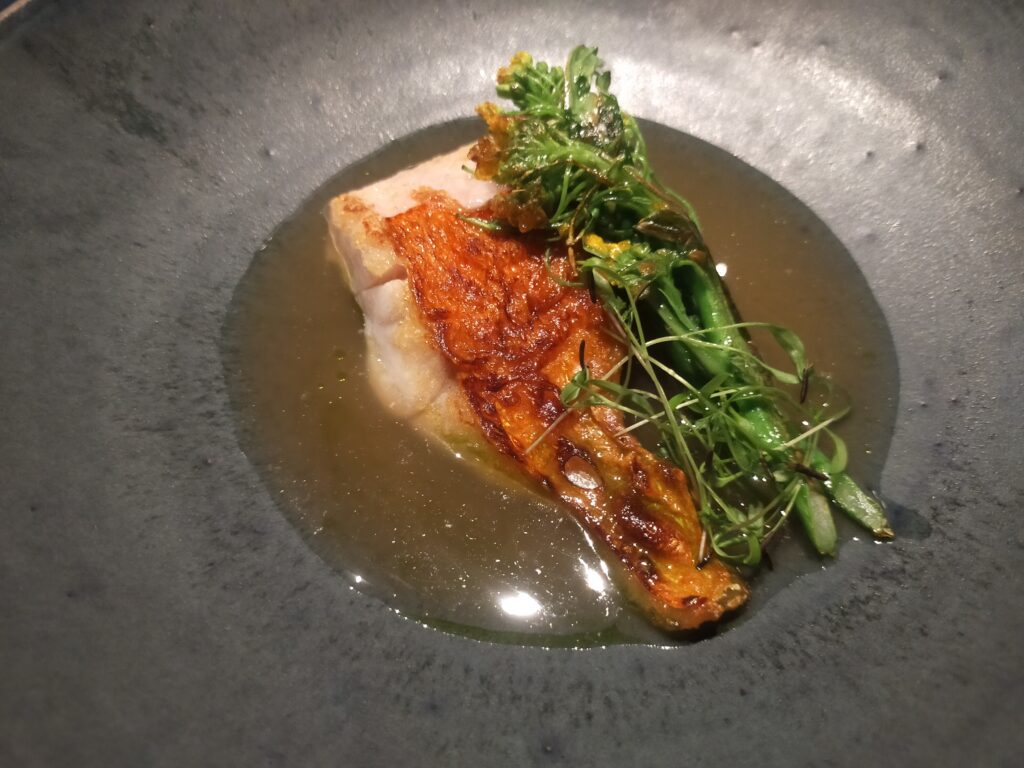
The accompaniments were sautéed Autumn Poem greens (a variety of asparagus greens) and sprouted scallions.
The soup poured at the end was made from broth extracted from the fish’s bones, infused with thyme and sage for added fragrance.
The texture of the collagen-rich soup paired seamlessly with the wine’s texture.
While earlier pairings intertwined the flavors of wine and food, this course seemed to showcase the wine itself.
The skin was crisped to perfection, yet the flesh remained astonishingly soft and tender without any stress from the cooking process.
How did they achieve this?
It was unbelievably delicious.
The combination of an outstanding dish with an equally amazing wine was a treat—but it’s a shame Comny’s liver capacity had reached its limit, making it harder to enjoy to the fullest.
Ninth Dish (Avant-Dessert)
The first dessert served was this:
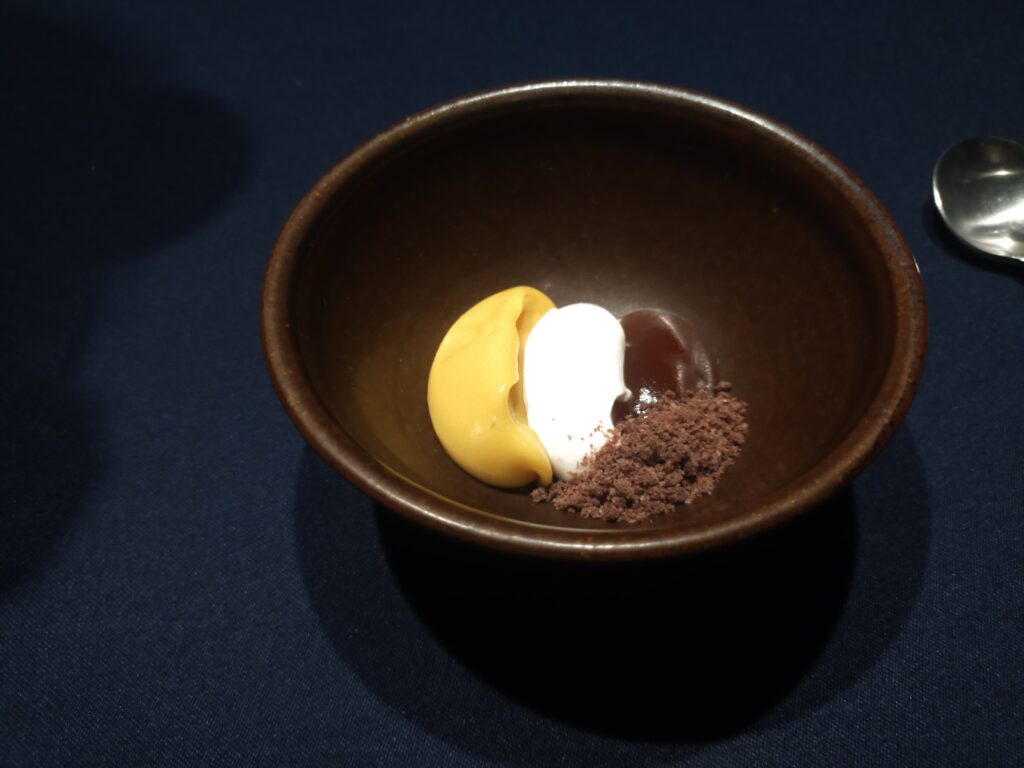
From left to right: sweet potato cream (Anno Imo), walnut cream, and roasted apple cream.
At the front, there was a crumble made from chocolate cookies.
To finish, a Sabaillon sauce made with sweet potato shochu was poured over the top.
Each of the creams was incredibly smooth, with a refined sweetness that let the natural flavors of the ingredients shine. They melted away effortlessly without any heaviness.
When paired with the shochu Sabaillon, the dessert transformed, gaining a bolder volume and becoming an elegant, grown-up treat.
It was simple yet felt like enjoying both a dessert and a post-meal digestif in one dish.
Tenth Dish (Dessert)
The finale was: Pear Bavarois
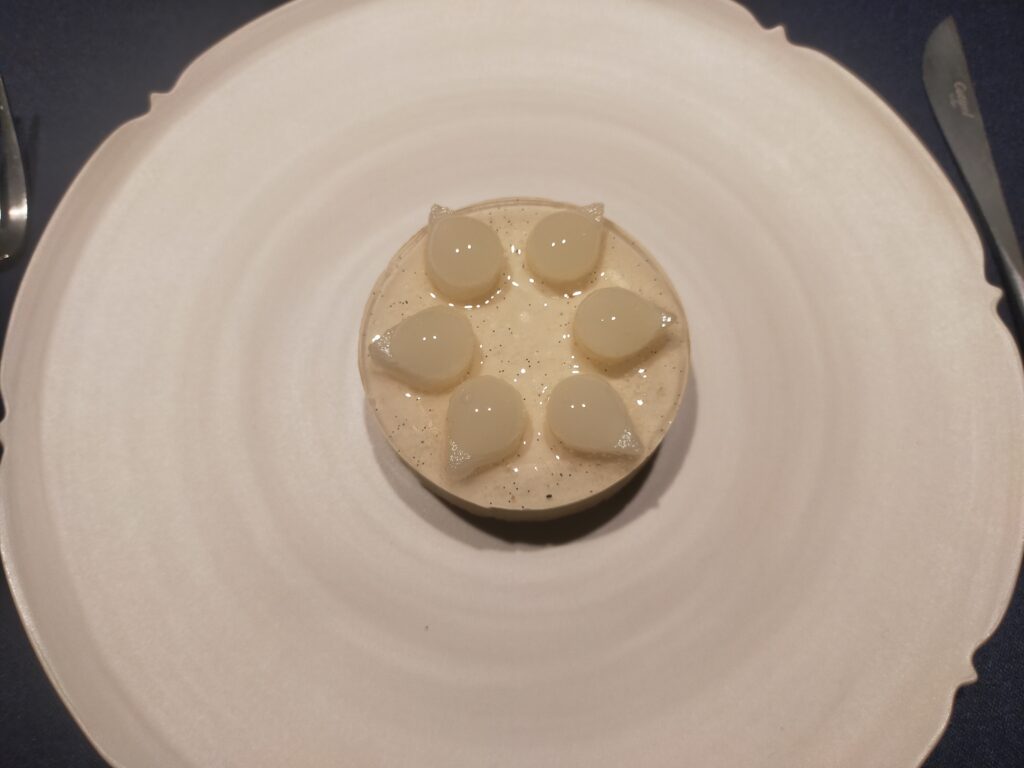
From the side, you could see the layers:
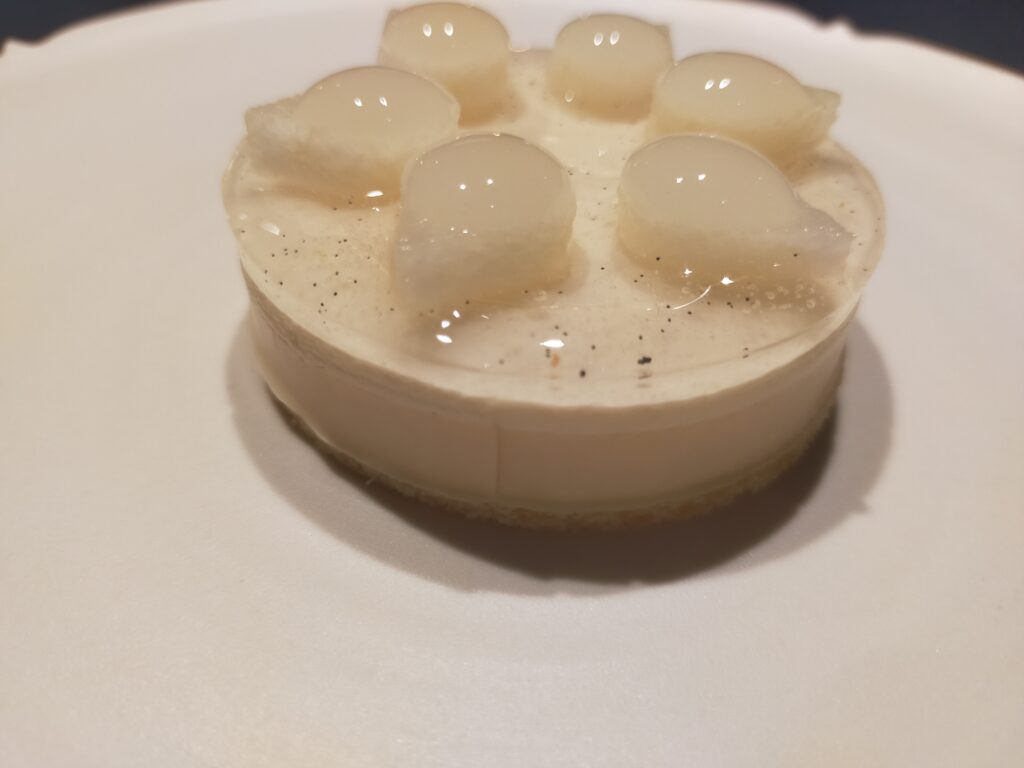
- The base was a pancake made from Suishou Buntan (a type of pomelo), topped with the Bavarois.
- On top of the Bavarois was a thin vanilla sheet, and above that, a scooped-out pear.
- Resting on the pear was a Buntan jelly that added a touch of acidity.
Though the components—pomelo, pear, and vanilla—were few, the dish had a variety of flavors that came together beautifully. It was absolutely delicious.
After-Meal Beverage
To finish the meal, we were served herbal tea.
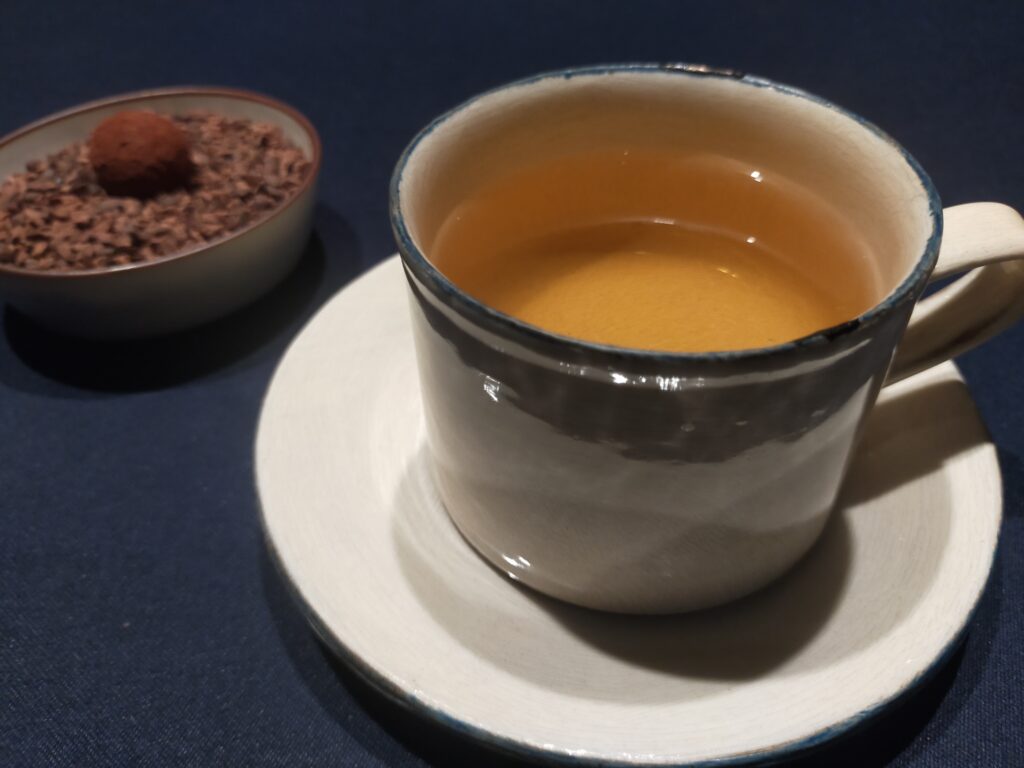
The refreshing scent of lemon balm was incredibly soothing, beautifully complementing the lingering flavors of the meal without disrupting the experience.
Despite feeling completely full, Comny savored the petits fours as well, leaving fully satisfied and delighted.
Thank you for the wonderful meal!
Final Thoughts
What did you think?
I hope I was able to convey even a fraction of how delicious everything was.
Even though I was in a half-hungover state (get it together, Comny!), I still thoroughly enjoyed the meal.
With no meat dishes on the menu (though that’s not the only reason), I felt full yet completely unburdened—a refreshing experience.
The food was, of course, exceptional, but I also learned so much about wine pairings.
Whether I make use of this experience or let it fade is entirely up to me, Comny. I’ll strive to improve even more moving forward.
Until next time!
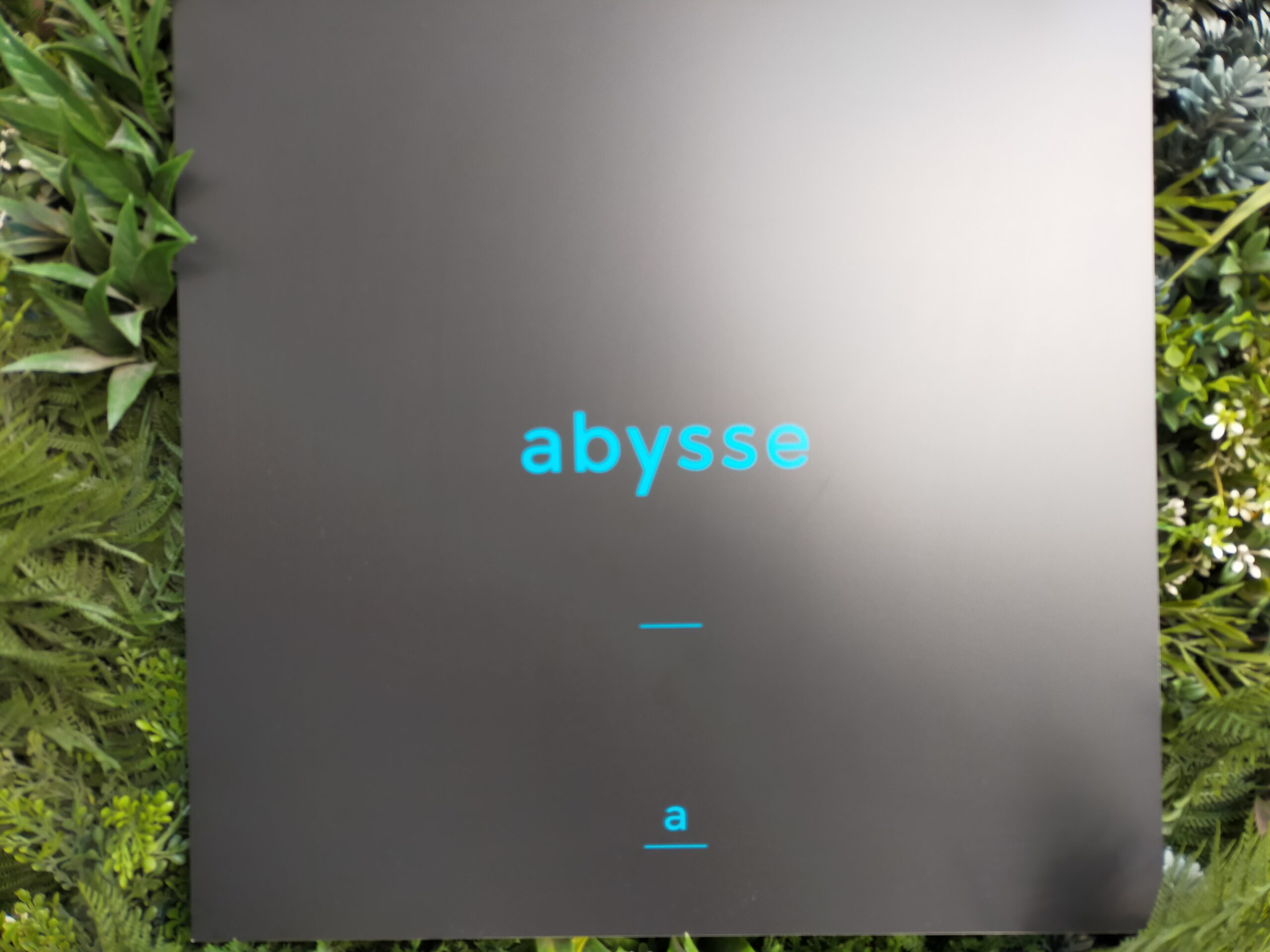





コメント